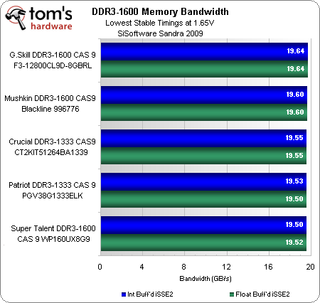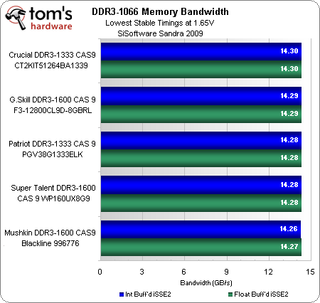High-Density DDR3: Five Dual-Module 8GB Kits Compared
Benchmark Results: Overclocking, Latency, And Bandwidth
Some of today’s modules are actually rated at 1.65V, but others still tolerate this mild 10% increase very well. That increase also coincides with Intel’s rated memory voltage limit for Core i7 processors, which is why so many “performance” brands use this as their recommended voltage. We used it for both overclock and latency-reduction testing and began by finding the highest achievable data rate for each module set at CAS 9.

We’ve noticed in several past reviews that heat spreaders appear to hinder heat transfer slightly at 1.65V, likely because the low heat produced at this voltage doesn’t efficiently penetrate the thermal interface material, which typically consists of double-sided foil tape. Lacking heat spreaders, Crucial's DDR3-1333 CAS 9 modules once again outpace the competition. This is something that power users must consider when seeking the highest possible memory capacity and frequency in the same part.
Now to find the lowest stable timings of each module set at standard speeds using a 1T command rate.
| Best Timings at 1.65V | |||
|---|---|---|---|
| Row 0 - Cell 0 | DDR3-1600 | DDR3-1333 | DDR3-1066 |
| G.Skill DDR3-1600 CAS 9 F3-12800CL9D-8GBRL | 7-8-7-15 | 6-7-6-12 | 5-6-5-10 |
| Mushkin DDR3-1600 CAS9 Blackline 996776 | 7-8-8-14 | 6-7-7-12 | 5-6-6-11 |
| Crucial DDR3-1333 CAS9 CT2KIT51264BA1339 | 8-8-7-17 | 7-6-6-14 | 5-5-5-11 |
| Patriot DDR3-1333 CAS 9 PGV38G1333ELK | 8-9-7-21 | 6-7-6-13 | 5-6-5-11 |
| Super Talent DDR3-1600 CAS 9 WP160UX8G9 | 8-9-8-14 | 6-8-6-13 | 5-6-5-11 |
Even though we received G.Skill’s high-speed (rather than low-latency) RAM, the brand still achieved the best timings at both DDR3-1600 and DDR3-1333. Power users seeking the shortest response times should be proud of this combination of capacity and latency.

G.Skill’s DDR3-1600 leads in Sandra Memory Bandwidth at its rated speed and minimum stable timings.

G.Skill’s latency win at DDR3-1333 keeps it in the lead at the processor’s standard memory speed.

Crucial managed to pull a surprising latency lead at DDR3-1066 and thus takes the Sandra Memory Bandwidth lead at the same speed.
Stay on the Cutting Edge
Join the experts who read Tom's Hardware for the inside track on enthusiast PC tech news — and have for over 25 years. We'll send breaking news and in-depth reviews of CPUs, GPUs, AI, maker hardware and more straight to your inbox.
Current page: Benchmark Results: Overclocking, Latency, And Bandwidth
Prev Page Test Settings Next Page Performance And Value Conclusion-
liquidsnake718 At an average of $200 dollars a stick I can safely say I am not an "Enthusiast" even though I love computers, hardware, consoles, games, and talking about computers.Reply
However my next build has almost been conceptualized (waiting for certain parts and prices), so DDR3 here I come.
-
falchard Its about twice as much as getting 8GB off 2GB Modules. So the price increase isn't too bad considering 4GB ram sticks are the largest you can currently buy. I am still waiting for that to dip in price and for the more massive ram sticks to come along. We have been max 4GB for quite some time now.Reply -
arkadi 4 now i can live with 12gb limit on my x58 mb. But it is good to know that ppl that really need more then that can do it for affordable priceReply -
Only problem I have with the review is where is the same tests on a AMD platform for all us AMD users that will be or are already looking at AMD AM3/DDR3 builds.Reply
-
Crashman micky_lundouch 400+ for 8gb ram?Reply
Yeh, ouch, but can you imagine paying $800 for it last summer? Newegg still has one of those super-expensive kits. -
verrul dont expect more than 4gb anytime soon there really is no need in a system to run more than 4 to begin with you really dont see any speed improvements past 4 and no program is built to handle that size of memory block currently. Sure there are the occasional special systems that use more than 4gb but not for a single program. Besides that there is the TDP and FCC inforced efficiency ratings they have to come in under ram is an energy hog for an overclockerReply -
Crashman terrybearOnly problem I have with the review is where is the same tests on a AMD platform for all us AMD users that will be or are already looking at AMD AM3/DDR3 builds.Reply
Tom's Hardware has recently been getting very similar overclocking and timing results between AMD and Intel systems when using the same modules and DIMM voltage. That's why the high-end system for the last two System Builder Marathons used the same RAM both times. -
anamaniac What about 16GBm 1066MHz DDR3 DIMM's? Only $1,700 a piece. =DReply
Granted, however, it is server ECC memory, and was never designed to be in a desktop. (Would love a 2P rig running dual 4GHz sexacore Gulftowns with HT, with 9 DIMM's per socket, running (18 DIMMs x 16GB/DIMM) 288GB of RAM.)
http://www.amazon.com/HP-Memory-240-pin-PC3-8500-registered/dp/B002I8SHK2
Most Popular


